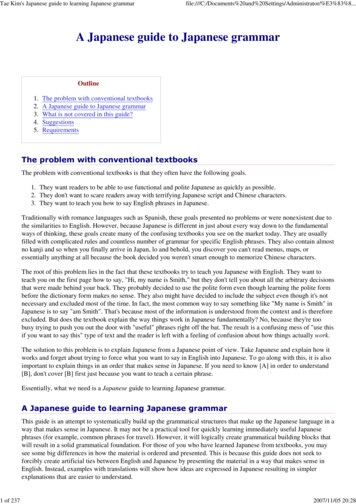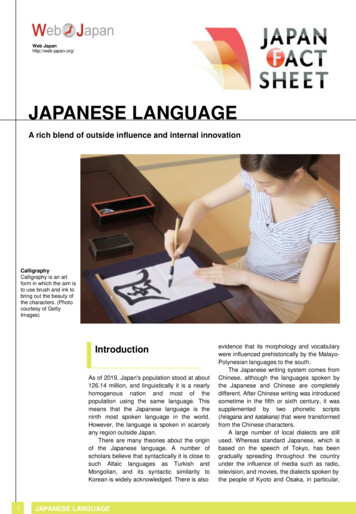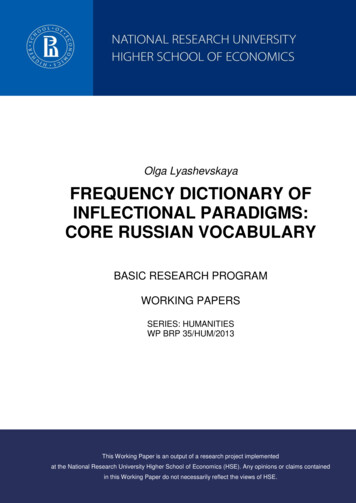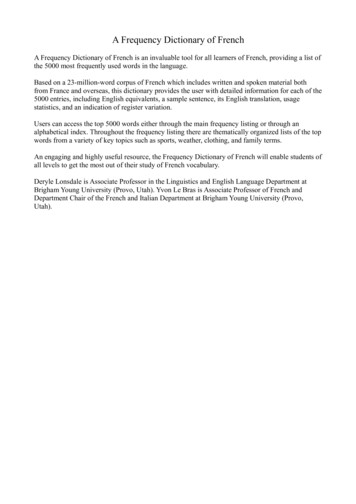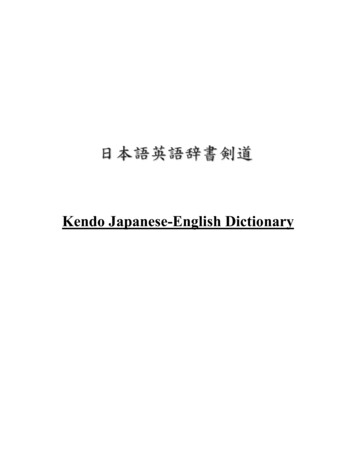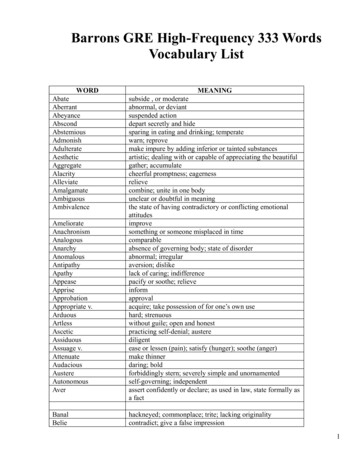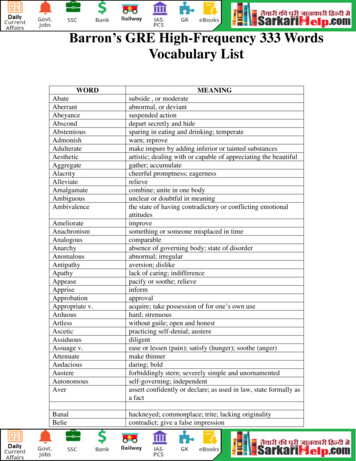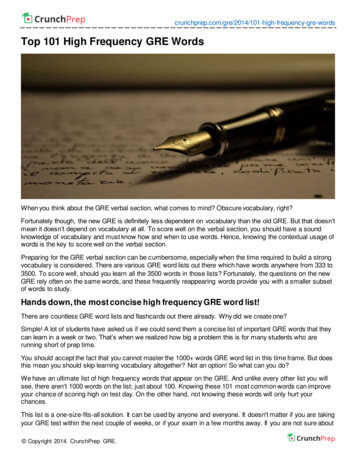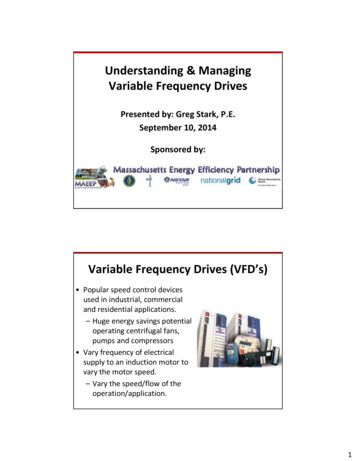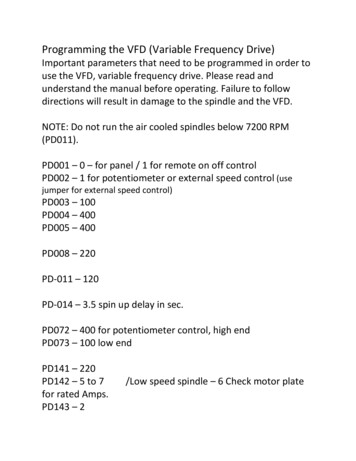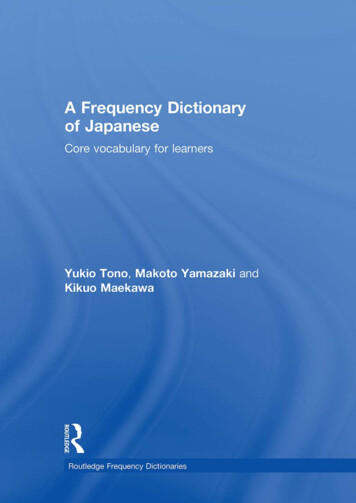
Transcription
A Frequency Dictionaryof JapaneseA Frequency Dictionary of Japanese is an invaluable tool for all learners of Japanese,providing a list of the 5,000 most commonly used words in the language.Based on combined corpora of over 107 million words—covering spoken and written,fiction and non-fiction registers—this dictionary provides the user with a detailedfrequency-based list, as well as alphabetical and part-of-speech indexes.All entries in the frequency list feature the English equivalent and a sample sentencewith English translation. The dictionary also contains 25 thematically organized lists offrequently used words on a variety of topics such as food, weather, occupations and leisure.Numerous bar charts are also included to highlight the phonetic and spelling variantsacross register.A Frequency Dictionary of Japanese enables students of all levels to maximize their studyof Japanese vocabulary in an efficient and engaging way. It is also an excellent resource forteachers of the language.Yukio Tono is Professor at the Graduate School of Global Studies, Tokyo University ofForeign Studies. Makoto Yamazaki is Associate Professor at the Department of CorpusStudies, the National Institute for Japanese Language and Linguistics. Kikuo Maekawa isProfessor at the Department of Corpus Studies, the National Institute for JapaneseLanguage and Linguistics.
Routledge Frequency DictionariesGeneral Editors:Paul Rayson, Lancaster University, UKMark Davies, Brigham Young University, USAEditorial Board:Michael Barlow, University of Auckland, New ZealandGeoffrey Leech, Lancaster University, UKBarbara Lewandowska-Tomaszczyk, University of Lodz, PolandJosef Schmied, Chemnitz University of Technology, GermanyAndrew Wilson, Lancaster University, UKAdam Kilgarriff, Lexicography MasterClass Ltd and University of Sussex, UKHongying Tao, University of California at Los Angeles, USAChris Tribble, King’s College London, UKOther books in the series:A Frequency Dictionary of ArabicA Frequency Dictionary of Mandarin ChineseA Frequency Dictionary of CzechA Frequency Dictionary of American EnglishA Frequency Dictionary of FrenchA Frequency Dictionary of GermanA Frequency Dictionary of PortugueseA Frequency Dictionary of Russian (forthcoming)A Frequency Dictionary of SpanishThe Frequency Dictionaries are all available as data CDs. These CD versions are specifically designed for useby corpus and computational linguists. They provide the frequency corpus in a tab-delimited format allowingusers the flexibility to process the material for their own research purposes.
A Frequency Dictionaryof JapaneseCore vocabulary for learnersYukio Tono, Makoto Yamazaki and Kikuo MaekawaRoutledgeTaylor & Francis GroupLONDON AND NEW YORK
First published 2013by Routledge2 Park Square, Milton Park, Abingdon, Oxon OX14 4RNSimultaneously published in the USA and Canadaby Routledge711 Third Avenue, New York, NY 10017Routledge is an imprint of the Taylor & Francis Group, an informa business 2013 Yukio Tono, Makoto Yamazaki and Kikuo MaekawaThe right of Yukio Tono, Makoto Yamazaki and Kikuo Maekawa to be identified as authors ofthis work has been asserted by them in accordance with sections 77 and 78 of the Copyright,Designs and Patents Act 1988.All rights reserved. No part of this book may be reprinted or reproduced or utilised in any form orby any electronic, mechanical, or other means, now known or hereafter invented, includingphotocopying and recording, or in any information storage or retrieval system, without permissionin writing from the publishers.Trademark notice: Product or corporate names may be trademarks or registered trademarks,and are used only for identification and explanation without intent to infringe.British Library Cataloguing in Publication DataA catalogue record for this book is available from the British LibraryLibrary of Congress Cataloging in Publication DataTono, Yukio.A frequency dictionary of Japanese : core vocabulary for learners / Yukio Tono, Kikuo Maekawa andMakoto Yamazaki.p. cm. – (Routledge frequency dictionaries)Includes bibliographical references and index.1. Japanese language–Word frequency–Dictionaries. 2. Japanese language–Dictionaries.3. Japanese language–Textbooks for foreign speakers–English. I. Makawa, Kikuo. II. Yamazaki, Makato.III. Title.PL685.T593 2013495.6′321–dc232012021445ISBN: 978-0-415-61012-4 (hbk)ISBN: 978-0-415-61013-1 (pbk)ISBN: 978-0-415-60104-7 (CD)Typeset in Parisineby Graphicraft Limited, Hong Kong
ContentsThematic vocabulary lists viSeries preface viiAcknowledgments ixAbbreviations xIntroduction 1References 9Frequency index 10Alphabetical index 247Part of speech index 302Word types (origins) 357
Thematic vocabulary lists1 Animals 2014 Plants 1412 Body 2915 School 1513 Clothing 3816 Shops 1604 Colors 4717 Sports 1695 Countries 5518 Taste 1786 Emotions 6519 Time 1887 Family 7720 Transportation 1978 Food 8621 Weather 2069 Furniture 9622 Words including letters of the alphabet 21510 Greetings 10523 o-/go- (Honorifics) 22411 House 11424 Honorific expressions 23312 Leisure 12325 Numbers/numerals 24313 Occupations 132
Series prefaceFrequency information has a central role to play in learning a language. Nation (1990)showed that the 4,000–5,000 most frequent words account for up to 95 per cent of awritten text and the 1,000 most frequent words account for 85 per cent of speech.Although Nation’s results were only for English, they do provide clear evidence that, whenemploying frequency as a general guide for vocabulary learning, it is possible to acquire alexicon which will serve a learner well most of the time. There are two caveats to bear inmind here. First, counting words is not as straightforward as it might seem. Gardner (2007)highlights the problems that multiple word meanings, the presence of multiword items,and grouping words into families or lemmas present in counting and analysing words.Second, frequency data contained in frequency dictionaries should never act as the onlyinformation source to guide a learner. Frequency information is nonetheless a very goodstarting point, and one which may produce rapid benefits. It therefore seems rational toprioritise learning the words that you are likely to hear and read most often. That is thephilosophy behind this series of dictionaries.Lists of words and their frequencies have long been available for teachers and learnersof language. For example, Thorndike (1921, 1932) and Thorndike and Lorge (1944)produced word frequency books with counts of word occurrences in texts used in theeducation of American children. Michael West’s General Service List of English Words (1953)was primarily aimed at foreign learners of English. More recently, with the aid of efficientcomputer software and very large bodies of language data (called corpora), researchers havebeen able to provide more sophisticated frequency counts from both written text andtranscribed speech. One important feature of the resulting frequencies presented in thisseries is that they are derived from recently collected language data. The earlier lists forEnglish included samples from, for example, Austen’s Pride and Prejudice and Defoe’sRobinson Crusoe, thus they could no longer represent present-day language in any sense.Frequency data derived from a large representative corpus of a language brings studentscloser to language as it is used in real life as opposed to textbook language (which oftendistorts the frequencies of features in a language, see Ljung, 1990). The information inthese dictionaries is presented in a number of formats to allow users to access the data indifferent ways. So, for example, if you would prefer not to simply drill down through theword frequency list, but would rather focus on verbs for example, the part of speech indexwill allow you to focus on just the most frequent verbs. Given that verbs typically accountfor 20 per cent of all words in a language, this may be a good strategy. Also, a focus onfunction words may be equally rewarding —60 per cent of speech in English is composedof a mere 50 function words. The series also provides information of use to the languageteacher. The idea that frequency information may have a role to play in syllabus design isnot new (see, for example, Sinclair and Renouf, 1988). However, to date it has been difficultfor those teaching languages other than English to use frequency information in syllabusdesign because of a lack of data.
viiiSeries prefaceFrequency information should not be studied to the exclusion of other contextual andsituational knowledge about language use and we may even doubt the validity offrequency information derived from large corpora. It is interesting to note that Alderson(2007) found that corpus frequencies may not match a native speaker’s intuition aboutestimates of word frequency and that a set of estimates of word frequencies collected fromlanguage experts varied widely. Thus corpus-derived frequencies are still the best currentestimate of a word’s importance that a learner will come across. Around the time of theconstruction of the first machine-readable corpora, Halliday (1971: 344) stated that “arough indication of frequencies is often just what is needed”. Our aim in this series is toprovide as accurate as possible estimates of word frequencies.Paul Rayson and Mark DaviesLancaster and Provo, 2008ReferencesAlderson, J. C. (2007) “Judging the frequency of English words.” Applied Linguistics, 28 (3): 383–409.Gardner, D. (2007) “Validating the construct of Word in applied corpus-based vocabulary research: a criticalsurvey.” Applied Linguistics, 28, pp. 241–65.Halliday, M. A. K. (1971) “Linguistic functions and literary style.” In S. Chatman (ed.) Style: A Symposium.Oxford University Press, pp. 330–65.Ljung, M. (1990) A Study of TEFL Vocabulary. Almqvist & Wiksell International, Stockholm.Nation, I. S. P. (1990) Teaching and Learning Vocabulary. Heinle & Heinle, Boston.Sinclair, J. M. and Renouf, A. (1988) “A lexical syllabus for language learning.” In R. Carter and M. McCarthy(eds) Vocabulary and Language Teaching. Longman, London, pp. 140–58.Thorndike, E. (1921) Teacher’s Word Book. Columbia Teachers College, New York.Thorndike, E. (1932) A Teacher’s Word Book of 20,000 Words. Columbia University Press, New York.Thorndike, E. and Lorge, I. (1944) The Teacher’s Word Book of 30,000 Words. Columbia University Press,New York.West, M. (1953) A General Service List of English Words. Longman, London.
AcknowledgmentsWe are first and foremost grateful to Paul Rayson and Mark Davies for their guidance andsuggestions throughout the project. We thank Adam Kilgarriff for reviewing our draftproposal and giving us useful suggestions. We are especially indebted to Yukari Honda, apostgraduate student at Tokyo University of Foreign Studies, who has worked closely withthe first author to organize the team of research assistants in writing the draft entries.Without her dedication, this work would not have been possible.We are also indebted to a number of research assistants who helped with this project:Yukari Honda, Makiko Kobayashi, Kanako Maebo, Kimie Abo, Satomi Kurusu, Tomoyo Fujita,Atsuko Yamashita, and Fumiko Watanabe.Special thanks to the National Institute for Japanese Language and Linguistics for theuse of the Balanced Corpus of Contemporary Written Japanese (BCCWJ) and the Corpus ofSpontaneous Japanese (CSJ). Thanks also go to the Japan Society for the Promotion ofScience for their financial support.Yukio TonoMakoto YamazakiKikuo Maekawa
AbbreviationsPart of m.p.p. casep. conj.p. ectivenumeralparticlecase particleconjunctive particlediscourse particleprefixpronounsuffixverbRegisterBKExample30 その sono adn. that39 そう soo adv. so, such50 せる seru aux. CAUSATIVE31 けれど keredo conj. though, although13 ている, てる te iru, te ru cp. CONTINUATION47 無い nai i-adj. There is no . . . , no . . .18 えー, ええ ee interj. eh?, what?; well, yes17 事 koto n. thing121 風 fuu na-adj. style, type, way, like1094 十 juu num. ten11 も mo p. too, also12 で de p. case in; at; from; by8 て te p. conj. REASON26 ね ne p. disc. isn’t it?, don’t you?2301 御 o prefix POLITENESS40 何 nani pron. what; something; anything; nothing1694 等 tou suffix and so on19 言う iu, yuu v. say, speak, talkExamplebooks1 の no p. case of; in; at; for; by 彼はこの大学の学生だ。— He is a student at this university.47078 0.98 BKNMnewspapers & magazines564 午後 gogo n. afternoon, p.m. 午後、会議がある。— There is a meeting in the afternoon.118 0.37 NMOFofficial documents106 ておる te oru cp. CONTINUATION (polite) お返事をお待ちしております。— I look forward to hearingfrom you at your earliest convenience.1017 0.63 OFSPspoken23 まー,まあ maa interj. Wow!, Oh my God! �— Wow! That’s amazing!6950 0.04 SPWBweb14 です desu aux. COPULA (polite) 彼は独身です。— He is single.9828 0.83 WB
IntroductionThe value of a frequency dictionaryof Japaneseprocessing (NLP), but people have not shown anyA Frequency Dictionary of Japanese provides a list ofrecently. Most NLP work has been carried out oncore vocabulary for learners of Japanese as a seconda large body of newspaper texts, and is thus notor foreign language. Like other volumes in thesuitable for educational purposes. There has beenRoutledge Frequency Dictionary series, it gives thevery little exchange of information betweenmost up-to-date, reliable frequency guidelines forhumanities and information sciences until the turncommon vocabulary in spoken and written Japanese,of the century. The advent of computers and corpuswhich helps learners of Japanese set practical goalslinguistics, however, has changed the whole picturefor acquiring both productive and receptiverecently, and the National Institute of Japaneseknowledge of vo
A Frequency Dictionary of Japanese enables students of all levels to maximize their study of Japanese vocabulary in an efficient and engaging way. It is also an excellent resource for teachers of the language. A Frequency Dictionary of Japanese Yukio Tono is Professor at the Graduate School of Global Studies, Tokyo University of Foreign Studies. Makoto Yamazaki is Associate Professor at the Department of
